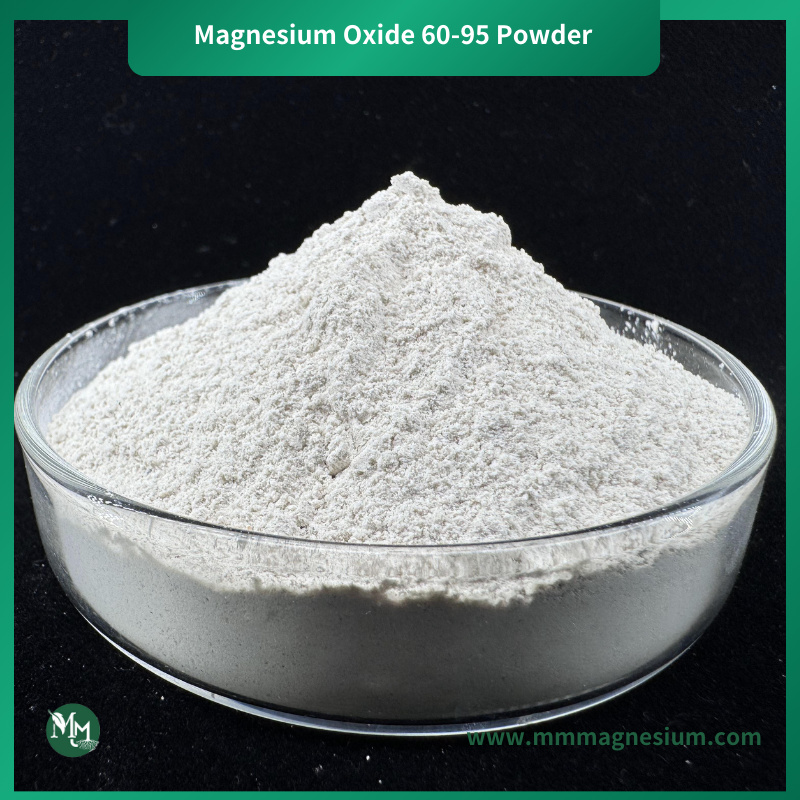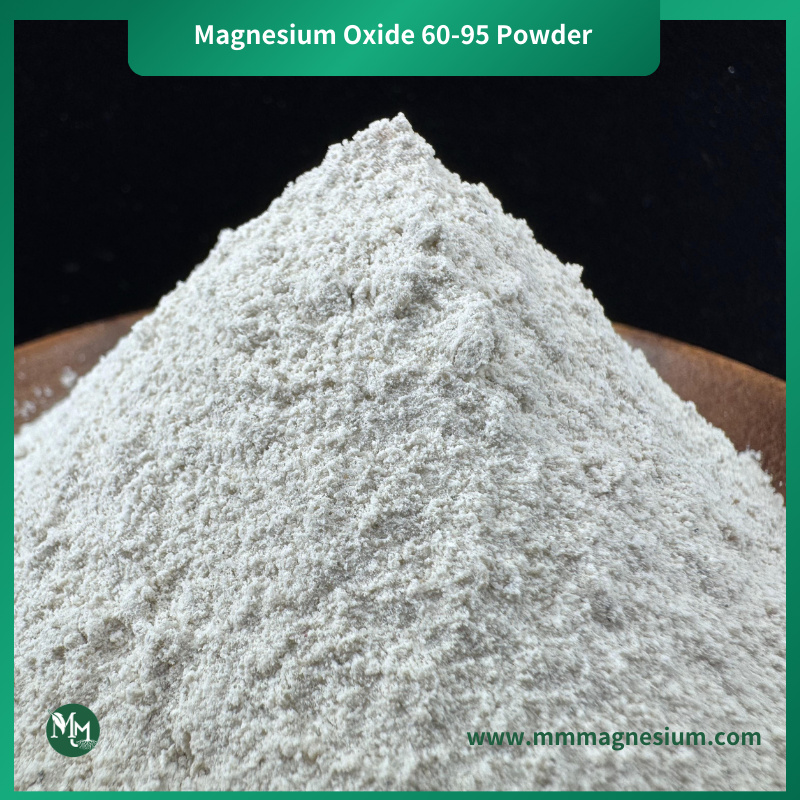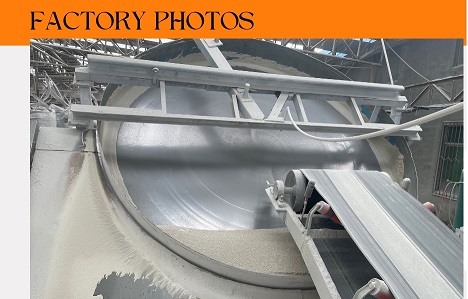

| TPYE | Caustic Soda≤ | Silicon≤ | Aluminum≤ | Iron≤ | Calcium≤ | Magnesium%≥ | Active Magnesium%≥ |
| 70white | 20.58 | 7.46 | 0.21 | 0.16 | 1 | 70.59 | 50+ |
| 70yellow | 11.13 | 11.21 | 1.31 | 0.66 | 5.49 | 70.2 | 40+ |
| 75white | 11.27 | 10.67 | 0.4 | 0.31 | 1.67 | 75.68 | 55+ |
| 75yellow | 7.99 | 10.99 | 0.61 | 0.74 | 3.2 | 76.47 | 45+ |
| 80white | 9.6 | 5.89 | 0.47 | 0.43 | 1.97 | 81.64 | 60+ |
| 80yellow | 4.31 | 8.78 | 1.01 | 0.87 | 2.36 | 82.67 | 50+ |
| 85white | 6.26 | 6.14 | 0.4 | 0.41 | 1.53 | 85.26 | 65+ |
| 85yellow | 3.56 | 6.34 | 0.71 | 0.77 | 2.27 | 86.35 | 55+ |
Magnesium oxide (chemical formula: MgO) is an oxide of magnesium, an ionic compound. It is a white solid at room temperature. Magnesium oxide exists in nature in the form of periclase and is the raw material for magnesium smelting.
Magnesium oxide has high fire-resistant insulation properties. It can be transformed into crystals after high-temperature burning above 1000°C, and it becomes dead-burned magnesium oxide (also known as magnesia) or sintered magnesium oxide when it rises to 1500-2000°C.
Magnesium oxide is commonly known as magnesia, also known as magnesium oxide. Magnesium oxide is an alkaline oxide with the common properties of alkaline oxides and belongs to a gelling material. White or light yellow powder, odorless, tasteless, non-toxic, is a typical alkaline earth metal oxide, chemical formula MgO. White powder, melting point is 2852°C, boiling point is 3600°C, relative density is 3.58 (25°C). Soluble in acid and ammonium salt solution, insoluble in alcohol. When exposed to air, it easily absorbs water and carbon dioxide and gradually becomes basic magnesium carbonate. Light products react faster than heavy products. It combines with water under certain conditions to generate magnesium hydroxide, which is slightly alkaline. The pH of the saturated aqueous solution is 10.3. It is soluble in acid and ammonium salts, but difficult to dissolve in water. Its solution is alkaline. It is insoluble in ethanol. It has strong refractive properties in the visible and near-ultraviolet light range.
Magnesite (MgCO3), dolomite (MgCO3·CaCO3) and seawater are the main raw materials for the production of magnesium oxide. Magnesium oxide is obtained by thermal decomposition of magnesite or dolomite. Magnesium hydroxide precipitate is obtained by treating seawater with slaked lime, and magnesium oxide is obtained by burning magnesium hydroxide. Magnesium chloride brine blocks obtained from the comprehensive utilization of seawater or brine after bromine extraction can also be used as raw materials, and sodium hydroxide or sodium carbonate are added to generate magnesium hydroxide or basic magnesium carbonate precipitate, which is then burned to obtain magnesium oxide.
Yingkou Maomei Agricultural Technology Co., Ltd. is located in Yingkou Dashiqiao City in the central and southern part of Liaoning Province, which is famous at home and abroad as the "China Magnesium Capital". Yingkou Maomei Agricultural Technology relies on high-quality magnesite mineral resources to produce magnesium oxide powder and granules, which are widely used in refractory materials, medicine and health, fertilizers, feed, and industrial fields.




Yingkou Maomei Agricultural Technology Co., Ltd. relies on high-quality mineral resources to produce magnesium oxide products with the following characteristics:
Products are exported to the United States, Russia, Indonesia, Canada, Spain, Malaysia, Bangladesh, and other countries, and also cover all provinces, cities, and regions across the country.
For more service advantages of Yingkou Maomei Agricultural Technology, please see Why choose us? and Factory Photos.
 |

|


Precautions for using magnesium oxide:

1. Protect from rain and sunlight, store in a ventilated and dry place, and do not transport or store together with toxic and hazardous substances.
2. Each bag is 25 kg, and we can also provide packaging as small as 1 kg or as large as ton bags according to customer requirements.
3. Plastic woven bags, lined with plastic inner bags. We provide all available packaging such as paper plastic bags/kraft paper bags/PE bags.
4. We provide a variety of transportation methods: road transportation, railway transportation, air transportation, container transportation, and ocean transportation.
5. Our company's marks can provide OEM or neutral marks.

Yes, we can provide detailed parameter descriptions of the products. Each product has detailed specifications, ingredients, usage methods and precautions. You can ask us for these materials to better understand and use our products.
2.Are your products in stock?
Most of our products are in stock and can meet your urgent needs. Please contact our sales team for specific stock status, and they will provide detailed information based on your order volume and needs.

 Magnesium oxide (MgO) is a widely used inorganic compound, widely used in building materials, refractory materials, fertilizers, medicine and environmental protection. Its price is affected by many factors, from raw material supply to market demand, to policy and environmental protection requirements. These factors work together to determine the market price of magnesium oxide.
Magnesium oxide (MgO) is a widely used inorganic compound, widely used in building materials, refractory materials, fertilizers, medicine and environmental protection. Its price is affected by many factors, from raw material supply to market demand, to policy and environmental protection requirements. These factors work together to determine the market price of magnesium oxide.
1. Raw material supply
1. Magnesite resources: Magnesite (MgCO₃) is the main raw material for the preparation of magnesium oxide. The reserves, mining difficulty and quality of magnesite directly affect the cost and price of magnesium oxide. When magnesite resources are abundant and the mining cost is low, the price of magnesium oxide is relatively stable and low; on the contrary, if magnesite resources are scarce or the mining cost is high, the price of magnesium oxide will rise.
2. Seawater and bittern resources: In addition to magnesite, seawater and bittern also contain a large amount of magnesium ions. These resources can be used to extract magnesium hydroxide by chemical methods and then calcined into magnesium oxide. The utilization efficiency, extraction technology and cost of seawater and bittern also affect the price of magnesium oxide.
II. Production cost
1. Energy cost: A large amount of heat energy is required in the production process of magnesium oxide, especially when calcining magnesite or magnesium hydroxide. Therefore, fluctuations in energy prices, especially changes in energy prices such as coal, natural gas and electricity, will directly affect the production cost and market price of magnesium oxide.
2. Labor cost: Labor cost is also an important part of magnesium oxide production. Changes in workers' wages, benefits and other related expenses will affect production costs. This factor is particularly significant in labor-intensive production environments.
III. Market demand
1. Industry demand: Magnesium oxide is widely used in construction, refractory materials, fertilizers, medicine and other industries. Changes in demand in these industries will directly affect the price of magnesium oxide. For example, the prosperity of the construction industry will increase the demand for magnesium oxide sheets, thereby driving up prices; while a decrease in demand in the steel industry may lead to a decrease in demand in the refractory market, which in turn affects the price of magnesium oxide.
2. International market: Magnesium oxide is a globally traded commodity, and the supply and demand situation in the international market will also affect its price. For example, the production situation of major producing countries and changes in demand in major importing countries will have an impact on international market prices. In addition, exchange rate fluctuations will also affect import and export costs, thereby affecting the international price of magnesium oxide.
IV. Policies and environmental protection requirements
1. Environmental protection policy: With the improvement of environmental protection requirements, environmental protection inputs and costs in the production process of magnesium oxide are also increasing. For example, in order to reduce carbon dioxide emissions, enterprises need to adopt more efficient production processes or increase investment in environmental protection equipment, which will increase production costs and thus affect the price of magnesium oxide.
2. Government subsidies and tax policies: Government subsidy policies and tax policies also have an important impact on the price of magnesium oxide. For example, some countries provide subsidies for the mining and processing of mineral resources, which helps to reduce production costs and stabilize market prices. On the contrary, if the government increases the mining tax or environmental protection tax on mineral resources, it will increase production costs and push up prices.
V. Technological progress
1. Production technology: Advances in production technology can improve the production efficiency of magnesium oxide and reduce production costs. For example, new calcination technology can reduce energy consumption, and efficient extraction technology can increase the recovery rate of magnesium ions. These technological advances can help stabilize or even reduce the price of magnesium oxide.
2. New materials and substitutes: The emergence of new materials and substitutes may affect the market demand for magnesium oxide, thereby indirectly affecting its price. For example, if new fireproof materials emerge and gradually replace magnesium oxide, its market demand will decline and its price will also be affected.
Yingkou Maomei Agricultural Technology Co., Ltd
Name: Brenda
Mobile:86-188-7490-2028
Tel:86-400-699-8826
Whatsapp:86-18874902028
Email:info@maomeimg.com
Add:Qianjia Village, Nanlou Economic Development Zone, Yingkou City, Liaoning Province, China